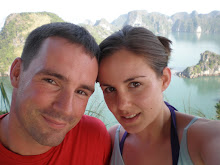Peace!


 VICTORY over the evil blog! I managed to click on the right button and re-establish that I was in fact not Japanese and voila, I am back in business. Though I have to say that it was a rude reminder that I need to take my learning the language more seriously.
VICTORY over the evil blog! I managed to click on the right button and re-establish that I was in fact not Japanese and voila, I am back in business. Though I have to say that it was a rude reminder that I need to take my learning the language more seriously.Anywho, these pictures are now from quite a few weeks ago. Adrian and I went to the Southern part of the island to visit the Prefectural Peace Museum and Park. Built to commemorate the WWII Battle of Okinawa, it sits on a cliff overlooking one of the many beaches that's so peaceful now but was an gruesome back drop of the last stages of the Pacific front in 1945.
It's a strange thing to walk through a museum and memorial to a war between people much like you and people much like those all around you. On the whole, once you leave the base here you often get a marked sense of being in the minority. I was particularly conscious of it when we walked into the park grounds. The building that houses the museum is surrounded by zigzagging black marble walls reminicent of the Vietnam war memorial in DC and serving the same grim purpose. These walls catalouge Japanese dead, civilian and military, in addition to US servicemen killed.
The number of Okinawan civilian deaths are much disputed. Some accounts say that 100,000 died in the American bombardment and ensuing fighting on the Southern part of the island from March to July of 1945. Okinawans called the American bombs that were meant to smoke out the Japanese soldiers the "Typhoon of Steel". It's probably an apt description given that it's estimated that there is still 3000 tons of unexploded ordinance on the island.
In addition to the damage done by American forces, the Japanese made their own signifcant dent in the civilian death toll. When the fighting began in the middle part of the island (where we now live) many civilians fled south and took refuge in naturally formed caves or family tombs. As the soldiers retreated from the bombings they followed suit and often forced hiding civilians out of the best hiding spots or crowded in with them. Moreover, Japanese soldiers were known to have killed civilians speaking Hogan (the Okinawan language) outlawed since the late 19th century when Okinawa became a prefecture beleiving them to be working as spies.
Many civilians were also conscripted into the fight. Famously, high school and middle school girls were forced to work as combat nurses to soldiers in the middle of war zones. 200 of these young girls were told such horror stories about the approaching American troops that they committed mass suicide in one of the caves rather than be captureed.
Another interesting part of the museum was the part detailing Okinawa since the war and the role that the U.S has played here since. From the end of the war until 1975, Okinawa was run by the "High Commissioner for the Ryukyu Islands", an American Lt. General. The museum detailed the movement for return to Japanese sovereignty, the communist movement here on island, the protests against the bases (most particularly during the Vietnam war when this was a major stop over and nuclear weapons began to be kept here, and again in 1995 when a group of US servicemen raped a young Okinawan school girl).
All in all an enlightening day but I will say, I would have loved to have had a translator as some portions of the museum were not in English and I was very curious to know what they said!


0 Comments:
Post a Comment
<< Home